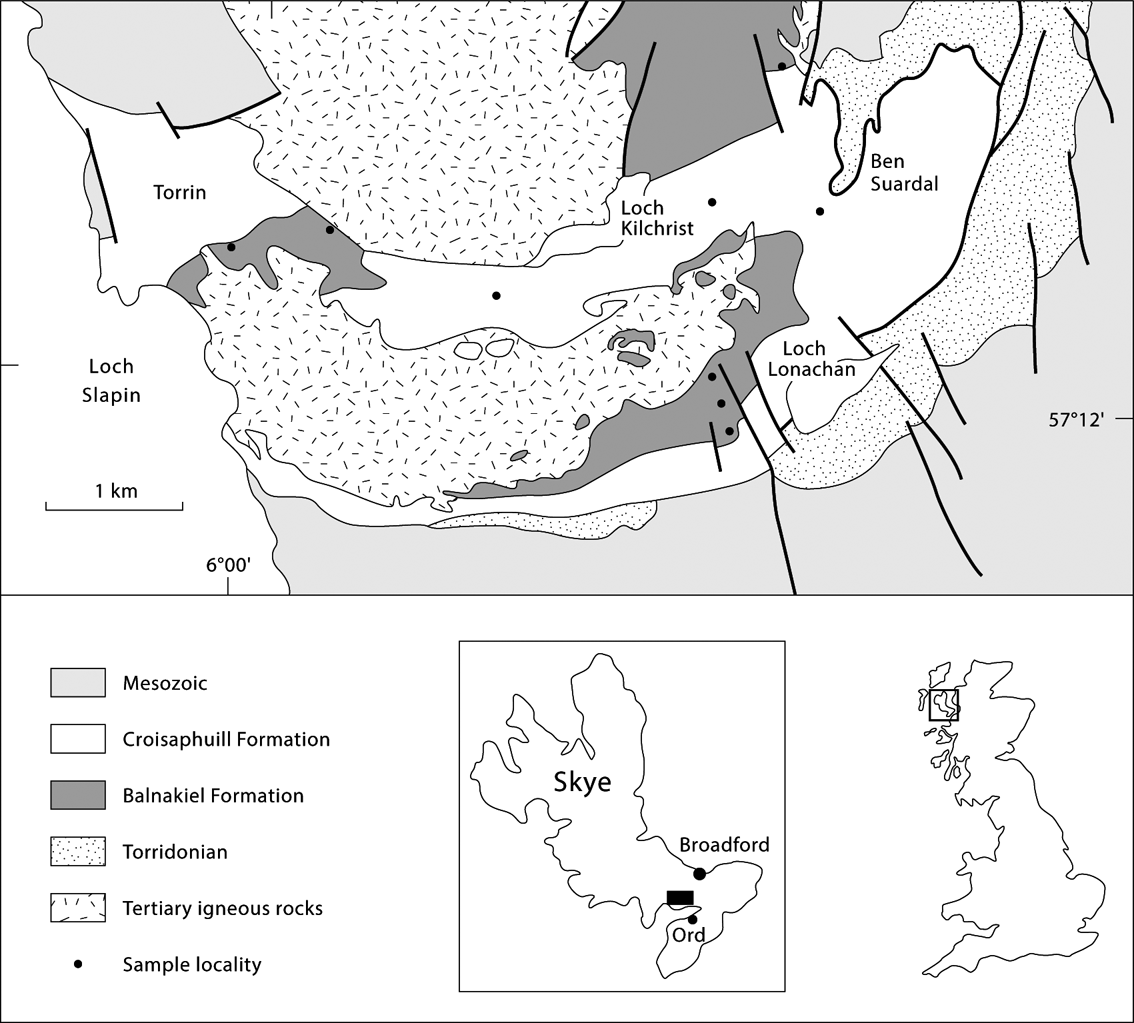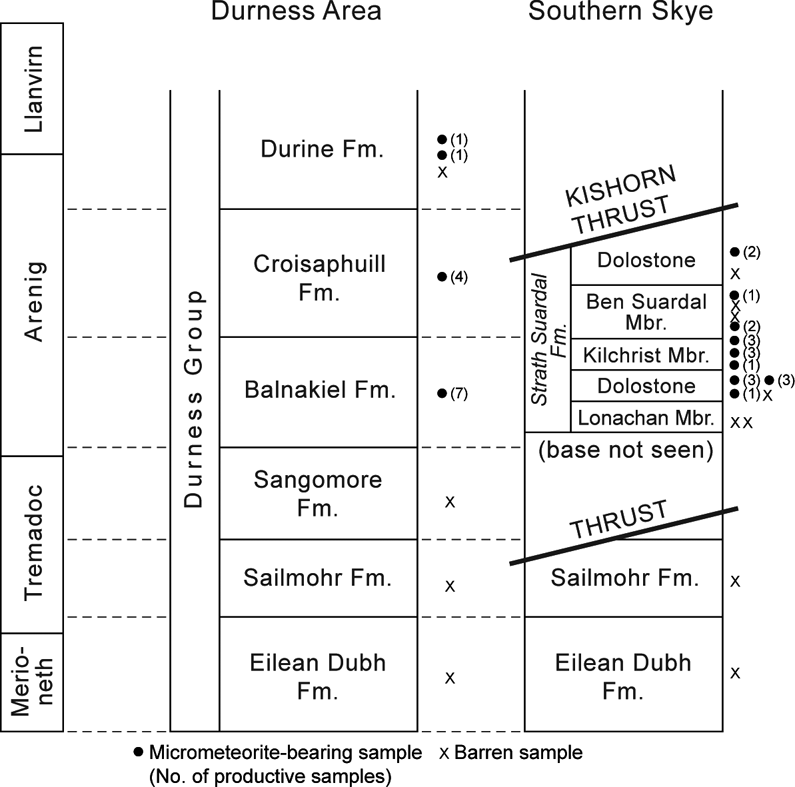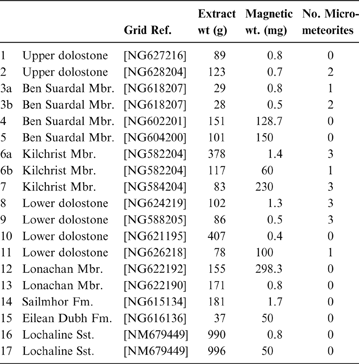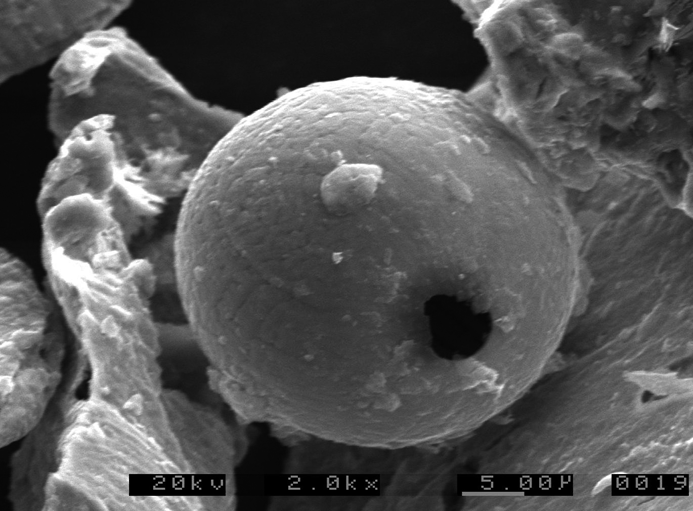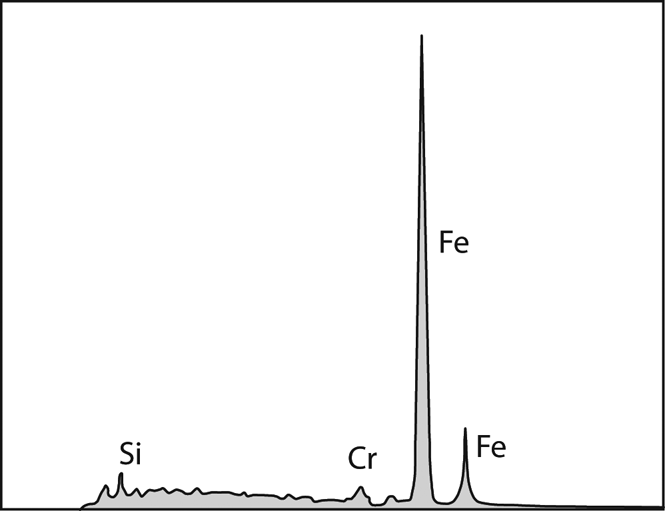Micrometeorites record a flux of extraterrestrial material to the Earth. Unlike megascopic meteorites, which arrive at a rate too low to be useful for measurements of palaeo-flux, micrometeorites arrive in sufficient quantities to measure their flux, and detect variations in it. Numerous studies from the modern environment, particularly in ice-/snow-covered terrains, yield collections and calculated fluxes of micrometeorites (e.g., Love & Brownlee Reference Love and Brownlee1993; Taylor et al. Reference Taylor, Lever and Harvey2000; Duprat et al. Reference Duprat, Engrand, Maurette, Kurat, Gounelle and Hammer2007). Fewer studies have been undertaken from the geological record (e.g., Taylor & Brownlee Reference Taylor and Brownlee1991; Davidson et al. Reference Davidson, Genge, Mills, Johnson and Grady2007; Onoue et al. Reference Onoue, Nakamura, Haranosono and Yasuda2011; Voldman et al. Reference Voldman, Genge, Albanesi, Barnes and Ortega2013), but several have linked high concentrations of micrometeorites to major meteorite impact events such as are associated with the Triassic–Jurassic boundary (Miono et al. Reference Miono, Nakayama, Shoji, Tsuji and Nakanishi1993; Chapman & Lauretta Reference Chapman and Lauretta2004) and the Cretaceous–Paleogene boundary (Grachev et al. Reference Grachev, Korchagin, Tselmovich and Kollmann2008).
The greatest concentration of meteorites known from the geological record is in the mid-Ordovician of Sweden (Schmitz et al. Reference Schmitz, Peucker-Ehrenbrink, Lindström and Tassinari1997, Reference Schmitz, Tassinari and Peucker-Ehrenbrink2001, Reference Schmitz, Häggström and Tassinari2003). An elevated concentration of extra-terrestrial chromite grains in the same rocks and coeval beds in China and Estonia show that there was a global delivery of extraterrestrial material at that time (Alwmark et al. Reference Alwmark, Schmitz and Kirsimäe2010; Cronholm & Schmitz Reference Cronholm and Schmitz2010). These meteorites are related to a breakup event in the Asteroid Belt, the imprint of which is still detectable in the isotopic dating of ∼25 % of meteorites arriving at the Earth today (Schmitz et al. Reference Schmitz, Häggström and Tassinari2003). The event was a single catastrophic disruption of an L chondrite parent body (Haack et al. Reference Haack, Farinella, Scott and Keil1996). Independent isotopic dating of shock in L chondrites yields a confirmatory mid-Ordovician date of about 470 Ma (Korochatseva et al. Reference Korochatseva, Trieloff, Lorenz, Buykin, Ivanova, Schwarz, Hopp and Jessberger2007). The asteroid breakup is provisionally identified as the origin of fragments in the Gefion family (Nesvorný et al. Reference Nesvorný, Vokrouhlický, Morbidelli and Bottke2009). The precise age of the meteorite-bearing beds in Sweden is early Darriwilian, within the Eoplacognathus variabilis conodont zone, spanning the traditional Arenig–Llanvirn boundary. A speculative search for micrometeorites in mid-Ordovician limestones of the Durness district, NW Scotland, yielded several micrometeorites up to 25 microns in size, all in formations approximately of Arenig age, but none in earlier strata. The preferential distribution in rocks of Arenig age, and calculation of a micrometeorite flux greater than the background flux, invites a link to the anomalous event recorded in Swedish strata (Dredge et al. Reference Dredge, Parnell, Lindgren and Bowden2010).That event is predicted to have involved an anomalous flux of extraterrestrial material lasting for several million years, which would have been distributed globally (Nesvorný et al. Reference Nesvorný, Vokrouhlický, Bottke, Gladman and Häggström2007; Parnell Reference Parnell2009). The Arenig age of the Scottish micrometeorites is within a few million years prior to the age of the meteorite-bearing strata in Sweden. However, the meteorites are interpreted to have arrived quickly, within as little as 105 years after the asteroid breakup (Heck et al. Reference Heck, Schmitz, Baur, Halliday and Wieler2004; Nesvorný et al. Reference Nesvorný, Vokrouhlický, Bottke, Gladman and Häggström2007). Therefore, we might have expected an increased flux of extraterrestrial matter after the Arenig–Llanvirn boundary, rather than just before. This difference may indicate that the event in the Asteroid Belt was more complex than a single breakup, or possibly that the micrometeorite data represents a less anomalous flux than originally interpreted. To further test the significance of the Durness micrometeorite record, a study was undertaken of a comparable stratigraphic succession through Durness Group limestones on Skye.
The objectives of the study were to:
(i) determine whether micrometeorites could be extracted from 1 kg samples of Durness Group limestone from Skye and were therefore susceptible to detection in a realistic sampling programme;
(ii) determine if any micrometeorites recorded show a preferred stratigraphic distribution;
(iii) compare the stratigraphic distributions between Skye and the Durness region; and
(iv) further assess the significance of the Arenig for micrometeorite occurrence by searching a sample of Dounans Limestone Formation from Lime Craig Quarry, Aberfoyle, Stirlingshire.
1. Geological setting
The limestones of the Durness Group were deposited in shallow marine environments, at the margin of the Laurentian continent which extended across much of what is now North America (Cocks & Torsvik Reference Cocks and Torsvik2002). The Durness Group in the Strath region of Skye (Fig. 1), named the Strath Suardal Formation, is approximately equivalent to the Balnakeil and Croisaphuill formations of the Durness district (Curry & Williams Reference Curry and Williams1984; Fortey Reference Fortey1992). A detailed lithostratigraphy was established by Holroyd (Reference Holroyd1994) and adopted on the British Geological Survey 1:50,000 Broadford map sheet (Emeleus & Bell Reference Emeleus and Bell2005). This stratigraphy allows subdivision of the Balnakeil/Croisaphuill succession into five units (Fortey et al. Reference Fortey, Harper, Ingham, Owen, Parkes, Rushton and Woodcock2000) (Fig. 2). The top of the succession in Skye is terminated by the current erosion surface. The underlying Sailmhor and Eilean Dubh formations are exposed to the south at Ord in an outcrop interpreted as a structural window (Emeleus & Bell Reference Emeleus and Bell2005).
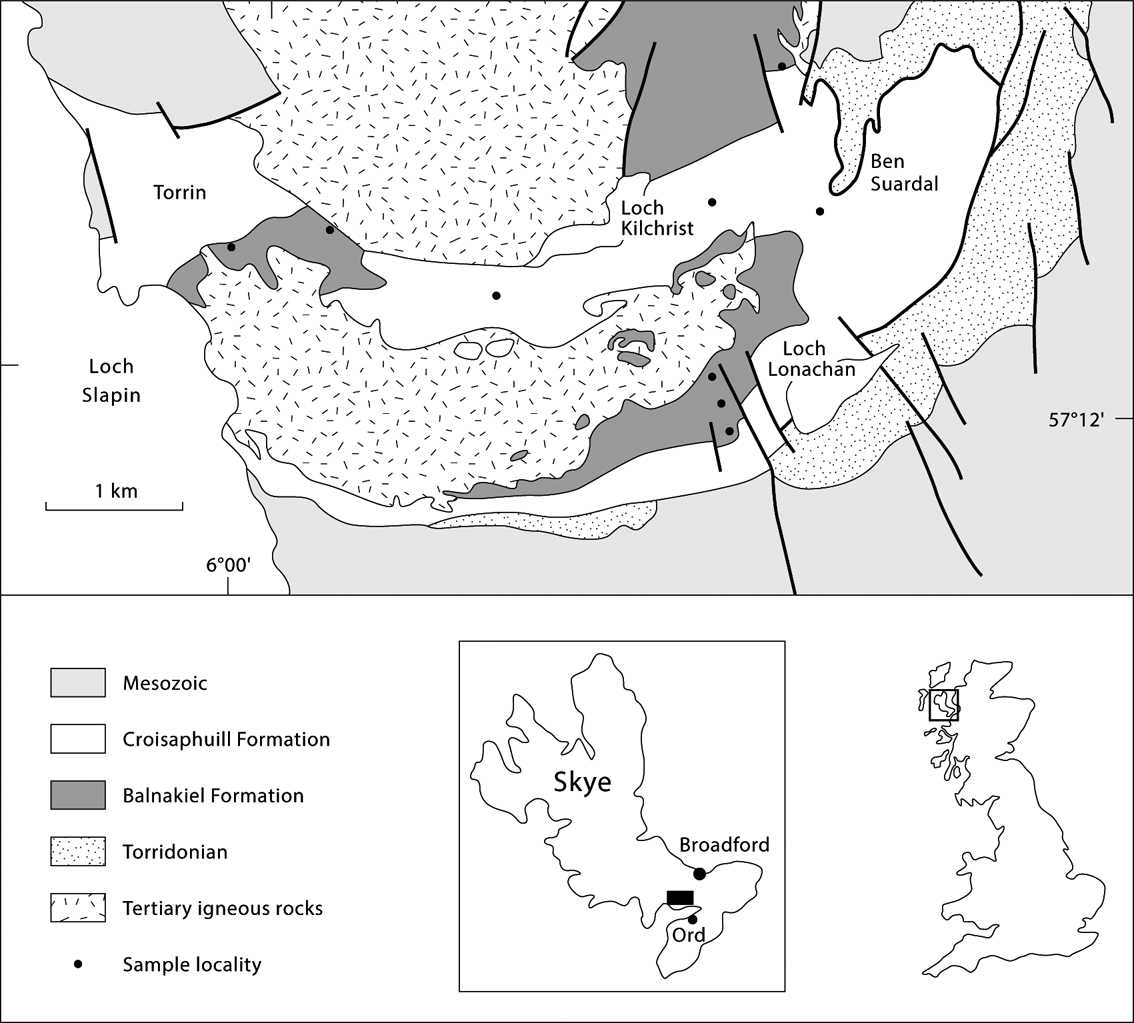
Figure 1 Location and geological map of study area, showing sample locations.
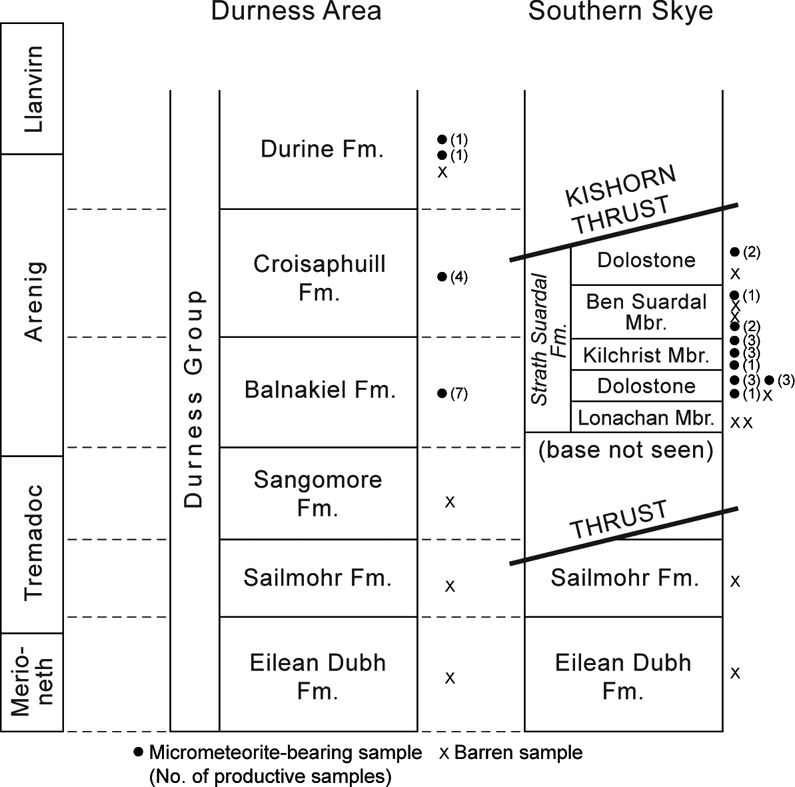
Figure 2 Stratigraphy of Durness Group limestones in Skye and the Durness area, showing correlations between the two areas, and the distribution of micrometeorite-bearing and barren samples. Numbers in brackets indicate number of micrometeorite-bearing samples.
The limestones are dolomitised to various degrees, and are locally metamorphosed to marble in the proximity of Tertiary plutonic bodies (Holness Reference Holness1992).
The limestone at Lime Craig Quarry is a sliver along the Highland Border Fault Zone, described by Ingham et al. (Reference Ingham, Curry and Williams1985).
2. Methodology
2.1. Sampling
Samples were collected from exposures of the Durness Group in the Strath and Ord regions of Skye. Specific sampling locations in the Strath region are shown in Figure 1. Fifteen samples were collected from thirteen localities. Two samples from the base of the succession were collected from Ord.
2.2. Processing and analysis
All rock samples were treated in the same manner. They were crushed to a powder using a fly press; then the powdered rock was weighed out to approximately 1 kg. The samples were then digested in dilute hydrochloric acid (10–20 %) to remove the carbonate content of the rock. This stage required the acid to be siphoned off and topped up several times (depending on the amount of carbonate material). Once the digestion had finished, the samples were washed, dried in an oven (∼60°C) and weighed. As the micrometeorites sought in this study are I-type cosmic spherules, their magnetic nature allows them to be separated from the rest of the sample (Suavet et al. Reference Suavet, Gattacceca, Rochette, Perchiazzi, Folco, Duprat and Harvey2009). Magnetic separation was achieved by systematically sweeping a hand magnet in a plastic sheath over c.10 g of the sample, flattened to a layer of single grain thickness. The magnet was then drawn beneath the magnetic fraction to separate the magnetic particles from those which were transported by static. This process was repeated until the whole sample had been processed. The magnetic fraction was then weighed, mounted on stubs or slides and carbon-coated, for examination using a scanning electron microscope (SEM) model ISI-ABT55, operated with a beam current of 15 to 20 nA, at an accelerating voltage of 15 kV. Micrometeorites were identified on the basis of specific criteria (see section 2.3 below).
Procedural control samples, using disaggregated quartz sand from the Cretaceous Loch Aline White Sandstone Formation, western Scotland, were processed in the same manner, to check for contamination by magnetic particles from modern sources.
2.3. Criteria for micrometeorite identification
The criteria adopted for identification of micrometeorites in the magnetic residue are rigorous. Only spherical particles are examined further, excluding almost all detritus that is irregular or exhibits crystal faces (many detrital magnetite grains have octohedral form).
Most spherical particles may be micrometeorites, but they were only accepted as definitely of this origin if they exhibit one of two distinctive features developed by micrometeorites during passage through the atmosphere. These features are the occurrence of dendritic patterns or dimples on the surfaces of the micrometeorites.
Many micrometeorites exhibit dendritic patterns of magnetite crystals on their surfaces, related to the micrometeorites' rapid cooling from high temperatures (Szöör et al. Reference Szöör, Elkes, Rozsa, Uzonyi, Simillak and Kiss2001; Taylor et al. Reference Taylor, Lever and Harvey2000; Stankowski et al. Reference Stankowski, Katrusiak and Budzianowski2006; Grachev et al. Reference Grachev, Korchagin, Tselmovich and Kollmann2008). Other micrometeorites exhibit dimples on the surface (Blanchard et al. Reference Blanchard, Brownlee, Bunch, Hodge and Kyte1980; Taylor & Brownlee Reference Taylor and Brownlee1991; Genge Reference Genge2008; Voldman et al. Reference Voldman, Genge, Albanesi, Barnes and Ortega2013; Prasad et al. Reference Prasad, Rudraswami and Panda2013). Phase separation during melting and then subsequent cooling can cause the formation of nuggets of distinct composition which become detached to leave a cavity (a dimple). A rigid shell develops upon initial cooling, which allows cavities to be retained upon expulsion of nuggets or gases (Marfaing et al. Reference Marfaing, Rochette, Pellerey, Chaurand, Suavet and Folco2008).
Particles exhibiting one or both of these criteria were analysed using energy-dispersive X-ray spectroscopy (EDX). Characteristic I-type spherules should show a prominent iron peak in such analyses.
3. Results
Micrometeorites were successfully extracted from nine of 17 Skye limestone samples (Fig. 3). Micrometeorites were found in the Upper Dolostone (two micrometeorites in one sample; none in a second sample), the Ben Suardal Member (numbers recovered 2, 1, 0, 0 in four samples), the Kilchrist Member (3, 3, 1) and the Lower Dolostone (3, 3, 1, 0). None were found in the Lonachan Member (two samples), the Sailmhor Formation (one sample) or the Eilean Dubh Formation (one sample), or in the two sandstone control samples. The extraction data are summarised in Table 1. The sample from Lime Craig Quarry also yielded a micrometeorite (Fig. 4).

Figure 3 Backscattered electron images of micrometeorites from Durness Group limestones in Skye: (A) micrometeorite, Lower Dolostone, Grid Reference [NG588205]; (B) dimpled micrometeorite, Upper Dolostone, [NG628204]; (C) micrometeorite with cavity (lower centre), Lower Dolostone, [NG624219]; (D) micrometeorite with dendritic surface, Lower Dolostone, [NG624219]. Note small satellite sphere which appears to be adjoined; (E) micrometeorite with dendritic surface, Ben Suardal Formation, [NG618207]; (F) micrometeorite with highly dendritic surface, Lower Dolostone, [NG626218].
Table 1 Extraction weights and micrometeorite occurrences in Durness Group limestones, Skye, and control samples of Lochaline Sandstone Formation
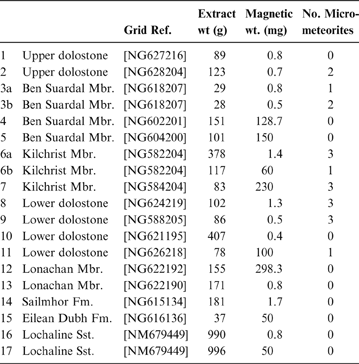
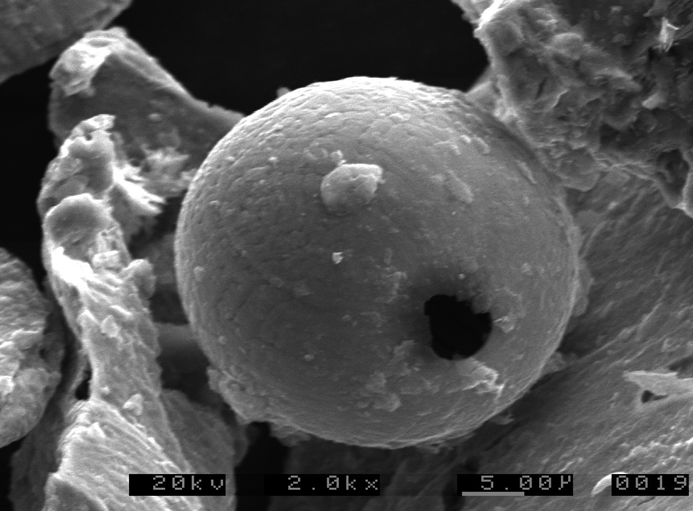
Figure 4 Backscattered electron image of micrometeorite from Arenig Dounans Limestone Formation, Lime Craig Quarry, Aberfoyle.
The overwhelming bulk (>99.9 %) of the magnetic separates consists of irregular, non-spherical particles with the high degrees of roundness that are characteristic of detrital magnetite. Detrital magnetite grains are abundant in almost all sedimentary rocks in northwest Scotland, having been derived from magnetite-rich Lewisian (Archean) basement, and are still very evident in modern beach sands in the region. The 20 particles identified as micrometeorites have very high roundness and sphericity, and have either dendritic patterns on their surface (13 samples) or dimples/cavities (seven samples). In some instances, the dendritic patterns cover the entire surface; in other cases, only parts of the surface. The dendritic patterns also vary from very well developed crystalline structures to barely discernible ones. Examples are shown in Figure 3. They range in diameter from 20 to 70 microns. One example (Fig. 3D) shows an apparently adjoined satellite sphere. Such adjoined spheres are shown in other reports of fossil micrometeorites (Castellarin et al. Reference Castellarin, Del Monte and Frascari1974; Grachev et al. Reference Grachev, Korchagin, Tselmovich and Kollmann2008), but their origin is unclear. The micrometeorites characteristically have a dominant iron peak on EDX spectra, with traces of silica and either titanium or chromium (Fig. 5).
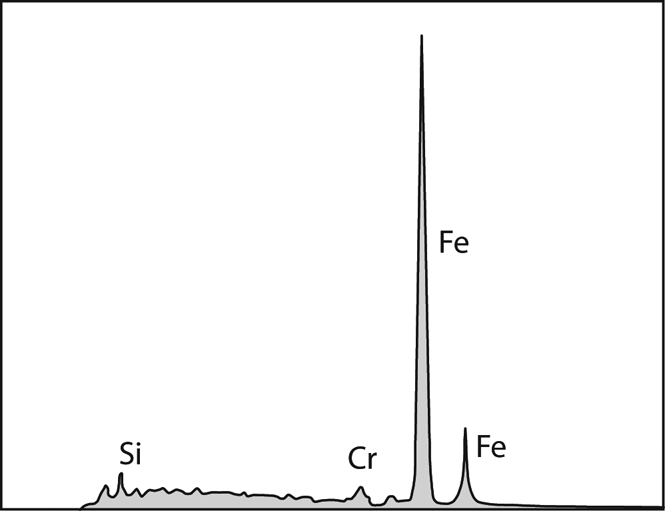
Figure 5 EDAX spectrum for micrometeorite from Dounans Limestone Formation, Lime Craig Quarry, Aberfoyle. Composition is dominated by iron, with traces of chromium and silica.
The micrometeorite-bearing samples were found in the upper four of the five units distinguished in the Strath region, but not in the lowermost unit or in the underlying formations sampled in the Ord region (Fig. 2). However, not all samples of the upper four units yielded positive results.
4. Discussion
4.1. Identity of micrometeorites
The strict application of the diagnostic criteria of dendritic patterns and dimples gives us confidence that the identified objects are genuine micrometeorites. The Earth surface environment is contaminated by magnetic particles of industrial origin (Doyle et al. Reference Doyle, Hopkins and Betzer1976; Puffer et al. Reference Puffer, Russell and Rampino1980; Wang & Chatterton Reference Wang and Chatterton1993), but these particles do not have the surface features that we have used to identify micrometeorites. The restriction of micrometeorites to specific stratigraphic levels, and the lack of micrometeorites in the procedural blanks, also confirms that contamination in the laboratory has not occurred.
4.2. Stratigraphic distribution
The data shown in Figure 2 indicate that there is a restricted stratigraphic distribution of the micrometeorites. This restriction is not determined by differences in sedimentation rate or by content of detrital/magnetic grains. The mean accumulation rates for the Balnakeil/Croisaphuill, Sailmhor and Eilean Dubh formations on Skye, calculated from thicknesses reported by Emeleus & Bell (Reference Emeleus and Bell2005) and time intervals of Gradstein et al. (Reference Gradstein, Ogg and Smith2004), are about 60 m/Myr and 20–30 m/Myr for the lower two. The proportions of detrital/magnetic grains in the samples are given in Table 1. The micrometeorite-bearing formations are not exceptional in either sedimentation rate or content of magnetic grains. In fact, the higher sedimentation rate in the Balnakeil/Croisaphuill formations is less conducive to finding micrometeorites, as they should be more diluted by sediment.
4.3. Comparison with Durness district data
A comparison of the distribution of micrometeorites in the Durness district and Skye is shown in Figure 2. The Durness data includes observations from the Durine Formation, additional to those made by Dredge et al. (Reference Dredge, Parnell, Lindgren and Bowden2010): two new extractions from this formation both yielded a single micrometeorite.
The stratigraphic range of micrometeorite occurrence in these units on Skye is less than for Durness. However, it is clear that in both regions there is a preferential occurrence of micrometeorites in the upper part of the succession, in the Balnakeil and Croisaphuill formations. The micrometeorite record from Lime Craig Quarry is consistent with the occurrences in Arenig rocks at Durness and Skye, but a single observation should not be overinterpreted.
4.4. Errors
Any errors that we have made in collecting and identifying micrometeorites would indicate that the numbers recorded are lower than true. The most likely sources of such error are in losses of particles during magnetic separation, and failure to recognise some micrometeorites. The conclusions about micrometeorite flux could also be underestimates, as we have used mean values for the rock deposition rate deduced from the whole sequence. The actual sedimentation rate of the piece of rock that was processed is likely to have been higher, because periods of non-deposition or erosion are not accounted for, and therefore the implied flux would be greater. However, there is no straightforward way to account for what happens to the incoming micrometeorites during periods of non-deposition or erosion. Periods of hiatus in sedimentation could give rise to higher concentrations on a bedding surface, while erosion could remove these concentrations but further concentrate them elsewhere. There is also the possibility of post-depositional concentration of micrometeorites on stylolite surfaces during dissolution of limestone. Our approach to these possibilities is to avoid samples with conspicuous discontinuities which could represent periods of abnormal accumulation rate, and to process sufficient samples overall so that variations in the calculated flux are statistically significant.
4.5. Interpretation
We can compare the flux of micrometeorites, relative to the general flux to the Earth. New data from Skye further support the elevated flux of micrometeorites, deduced for the Balnakeil and Croisaphuill formations in the Durness district by Dredge et al. (Reference Dredge, Parnell, Lindgren and Bowden2010), of about one micrometeorite with a size of >100 µm per square metre per year (Maurette Reference Maurette2006). The <20 µm size fraction is about five times as abundant for I-type spherules (Taylor et al. Reference Taylor, Lever and Harvey2000), equivalent to a flux of 5 x 106 per m2/Myr. The 19 I-type spherules identified from Skye were extracted from 13 samples each of 1 kg mass in the upper part of the succession. This represents about 1.46 spherules per kilogram of rock. Assuming a limestone density of 2,600 kg/m3, this is equivalent to 3,800 spherules per m3. For a mean sedimentation rate of 60m/Myr, the mean spherule accumulation rate is about 2.3×105 per m2/Myr. The ratio of cosmic spherules to unaltered micrometeorites in Antarctic samples increases with size, constituting about 20 % in the 50–100 µm size fraction (Maurette Reference Maurette2006). Therefore, in the size range represented by the Durness Group micrometeorites, we expect the cosmic spherules to represent at least an order of magnitude more of un-melted micrometeorites. Only about 2 % of the Antarctic cosmic spherules are I-type (Taylor et al. Reference Taylor, Lever and Harvey2000), so the total number of original micrometeorites could be 500+ times as great as the observed number of I-type spherules, elevating the rate to 1.1×108 micrometeorites per m2/Myr. These estimates indicate a micrometeorite flux in the upper part of the Durness Group about 20 times greater than normal. Although the numbers are limited, and the statistics should be treated with caution, this flux is consistent with the mid-Ordovician meteorite flux having been increased by one to two orders of magnitude, as concluded by Schmitz et al. (Reference Schmitz, Peucker-Ehrenbrink, Lindström and Tassinari1997, Reference Schmitz, Tassinari and Peucker-Ehrenbrink2001).
Unfortunately, the absence of younger rock units prevents us from defining an upper stratigraphic limit to the elevated flux. Although it is tempting to relate the elevated flux of micrometeorites to the elevated flux of meteorites found in Sweden (Schmitz et al. Reference Schmitz, Peucker-Ehrenbrink, Lindström and Tassinari1997, Reference Schmitz, Tassinari and Peucker-Ehrenbrink2001), there is a mismatch in time. The biostratigraphic context for the Swedish meteorites, in the Eoplacognathus variabilis conodont zone (Schmitz et al. Reference Schmitz, Häggström and Tassinari2003), is known with high precision. The micrometeorite-bearing Balnakeil Formation is upper Tremadocian–lower Floian in age (Fortey et al. Reference Fortey, Harper, Ingham, Owen, Parkes, Rushton and Woodcock2000), preceding the Swedish meteorite-bearing strata. The time gap, interpreted from the data of Gradstein et al. (Reference Gradstein, Ogg and Smith2004), is about 5 Myr, which is greater than the delivery time (<1 Myr) for the meteorites since the breakup event.
The micrometeorites identified in the Durness Group limestones are generally much smaller than the chromite grains from the Swedish deposits used to calculate cosmic ray exposure ages and, hence, the travel times from parent body breakup to arrival at the Earth (Heck et al. Reference Heck, Schmitz, Baur, Halliday and Wieler2004, Reference Heck, Schmitz, Baur and Wieler2008). Smaller particles are more susceptible to Poynton–Robertson drag (Burns et al. Reference Burns, Lamy and Soter1979), so could have arrived earlier, but only earlier within the very short (<1 Myr) delivery time after the breakup event. Therefore, the micrometeorites reported here must represent some earlier event(s). Some of the chromite grains analysed by Meier et al. (Reference Meier, Schmitz, Baur and Wieler2010) do have longer cosmic ray exposure ages (one third have ages of >3 Myr), but these authors reject an explanation of earlier impact/ejecta events, and prefer to interpret the longer exposure ages as indicating exposure within the regolith on the parent body. In a case of helium measurement around the time of a Palaeogene meteoroid shower, anomalous 3He, indicating an extra-terrestrial component, was found to occur in strata over half a million years earlier than the impacts (Farley et al. Reference Farley, Montanari, Shoemaker and Shoemaker1998). Helium-3 (3He) is strongly associated with magnetite, suggesting early arrival of micrometeoritic material. However, although anomalous levels of 3He were also identified within the meteorite-bearing beds in Sweden, they do not occur below it (Patterson et al. Reference Patterson, Farley and Schmitz1998), thus offering no supporting evidence for early arrival of micrometeorites.
It is possible that we are seeing, in the Durness Limestone, evidence of a longer-term anomalous flux of extraterrestrial matter, not specifically related to the mid-Ordovician meteorite event. Other evidence for an anomalous flux in the Lower Palaeozoic comes from a delivery rate much higher than at present; apparent from collections made from Silurian salt (Mutch Reference Mutch1964) and Tremadocian to Darriwilian limestones in Argentina (Voldman et al. Reference Voldman, Genge, Albanesi, Barnes and Ortega2013). The dating of impact craters suggests a higher cratering rate from at least 470 Ma to 440 Ma (Cronholm & Schmitz Reference Cronholm and Schmitz2010), which also implies longer-term delivery of meteoritic material.
A further mismatch between the micrometeorites reported here and samples from the 470 Ma meteorite event is in their respective mineralogies. The parent body of the Swedish meteorites was an L-chondrite (Korochatseva et al. Reference Korochatseva, Trieloff, Lorenz, Buykin, Ivanova, Schwarz, Hopp and Jessberger2007), from which we might expect a predominance of silicate-based micrometeorites. Although our extraction technique only yields magnetic micrometeorites, if they represented only a minor component then our data imply a much greater total flux.
Two of the samples (localities 7 and 9) were marbles, in the close vicinity of a Tertiary granite. Both of these samples yielded micrometeorites, showing that metamorphism does not prevent their detection, and raises the prospect of assessing micrometeorite fluxes in meta-limestones from the deep geological record.
5. Conclusions
The analyses presented here of limestones from the Durness Group on the Isle of Skye show that micrometeorites can be successfully extracted from limestones using samples of 1 kg in size. The micrometeorites appear to occur preferentially in the upper part of the succession, in the Strath Suardal Formation of Arenig age, which is consistent with previous measurements made in limestones from the Durness area. This finding further suggests a period of elevated micrometeorite flux in the mid-Ordovician. The similarity in the stratigraphic distribution in the Skye and Durness areas also implies that the preferred stratigraphic distribution determined for Skye is meaningful, and not a consequence of limited sampling.
6. Acknowledgements
B. Fulton and A. Sandison provided skilled technical assistance. NS was in receipt of a Carnegie Vacation Scholarship, which was the basis of this project. Referees M. Lee and M. Genge and the Editor considerably improved earlier versions of the manuscript, for which we are very grateful.


